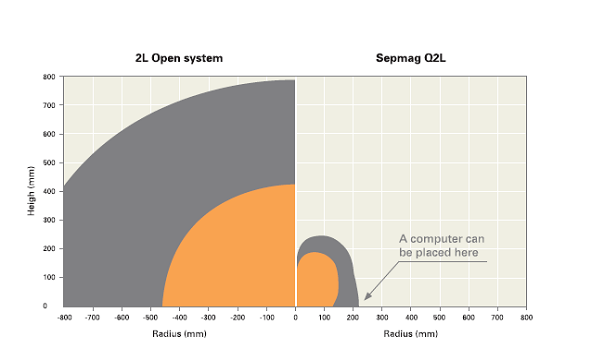Scaling up biomagnetic separation process is not just about quantity and quality of the production. One of the main concerns is the operational safety of using ‘big magnets’. As most of the classical magnetic separators are assemblies of permanent magnets in an open configuration, the use of large versions of these devices raises legitimate concerns about the risk for the operators and other laboratory/production equipment. As we will discussed later, the problem does not longer exist using advanced biomagnetic separation systems, but understanding the risks is also key for successfully implement in production environment.
Let us just review the definition and level of risk due to the presence of strong magnetic fields. The first level is related with the risk of affecting watches, instruments and magnetic recording materials (include here the hard disk of computers!), and it includes pacemakers and other electronic medical implants. For avoiding this risk, we should define a CAUTION AREA where people fitted with medical devices should never enter, and where you should not place the instruments or materials susceptible to be affected by the magnetic field (note that it includes credit cards and similar). The CAUTION AREA is defined as the region where the magnetic field exceeds 0.5 mT (5 Gauss), roughly 10 times the Earth magnetic field.
However, the main risk for most people is the potential injuries caused by the mechanical movement of magnetic or magnetizable objects due the interaction with separation device. Carrying around steel tools like scissors, screw-drivers, hammers… put a person in risk. The magnetizable object can be strongly attracted by the stray magnetic fields of the separators and harm the person if parts of the body are in the trajectory. As the force increases very quickly when approaching to the field source, when the carriers feels the force is usually too late to react. The magnetic field level to define the DANGER AREA is settled in 3 mT (30 Gauss).
For classical magnetic separators (and still worst for big magnet blocks) the DANGER and CAUTION areas are quite large. Note that you need to consider the CAUTION AREA as the effective footprint of your system, as you can’t place any computer or instruments inside it, becoming the main limitation for using the space of your clean room or laboratory.
In the example, the magnetic footprint of the classical magnetic separator (left map) requires more than 3 m2. By contrast, advanced biomagnetic separators show very little stray fields (right field map). For the same working volume (2 L vessel), the last has a magnetic footprint of just 0.15 m2, occupying jus 1/20 of the space of the clean room or laboratory than the classical device. The reason of this different performance in safety is that advanced systems focus almost all the magnetic energy of the permanent magnets on the working volume, minimizing the magnetic field outside the device. This intrinsic safe design has allowed SEPMAG®’s customers to easily integrate biomagnetic separation systems up to tens of liters in their existing facilities without need of remodeling or special measures. This short danger distance also permits place different biomagnetic separators in the same lab, increasing production capability (duplicating the volume capacity) and/or flexibility (when different systems process use different volumes). Moreover, the ability to place instruments near each other has also allowed the development and integration of the optical monitoring system. Such option would have been more difficult to implement, especially for very large volume systems, if computers couldn’t be placed near the permanent magnet assembly.
Related post:
- How to Select the Right Biomagnetic Separation Conditions
- How to Scale-up the conditions to a new volume
- How to Monitor Scaling-up Process





